How to Preserve and Store Spices
- April 1, 2024
- 0 comment
Discover how to preserve and store spices to maintain their freshness and flavor, a crucial aspect of enhancing culinary creations. This comprehensive guide covers effective methods to ensure the longevity and potency of your spices, transforming everyday meals into exceptional culinary experiences.
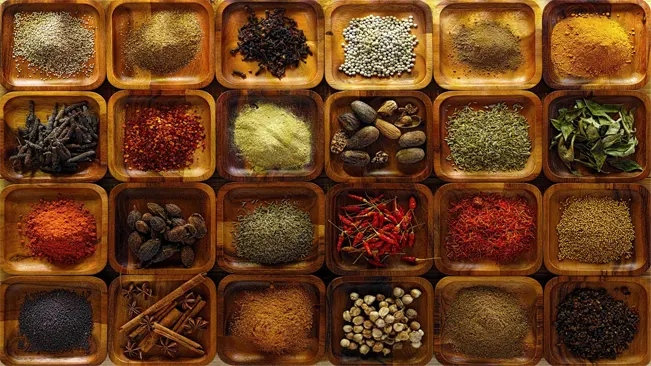
Understanding Spice Deterioration
Spices are rich in essential oils and compounds that give them their distinctive flavors and aromas. However, these compounds are highly sensitive to environmental factors, which can lead to the deterioration of spices over time.
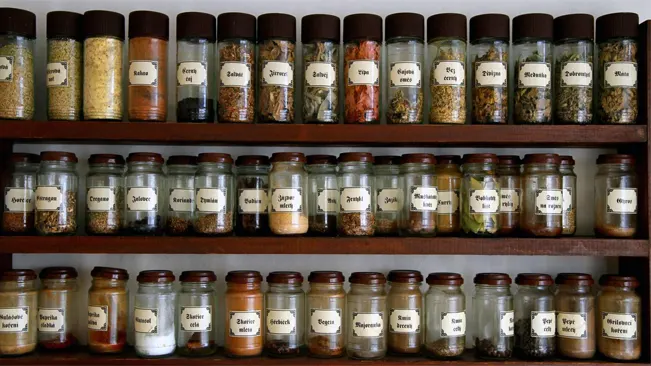
- Air Exposure: When spices are exposed to air, they undergo oxidation. This chemical process involves the spice compounds reacting with oxygen, leading to a gradual loss of flavor and aroma. Oxidation can also alter the chemical structure of the spice, reducing its overall quality and potency.
- Light: Direct light, especially sunlight, can have a deleterious effect on spices. Ultraviolet (UV) and visible light can break down the delicate compounds in spices, leading to faded colors and diminished flavors. This is why spices often lose their vibrant appearance and become pale or discolored when left in light-exposed areas.
- Heat: Heat accelerates many chemical reactions, including those that lead to the deterioration of spices. High temperatures can cause the volatile oils in spices to evaporate more rapidly, leading to a significant loss of aroma and flavor. Heat can also speed up oxidation and other degrading processes.
- Moisture: Moisture is particularly harmful to spices. The presence of water can lead to mold growth and bacterial contamination, especially in ground spices. It can also cause clumping, making the spices difficult to use. Furthermore, moisture can trigger enzymatic reactions, which may alter the flavor profile of spices.
Optimal Storage Conditions
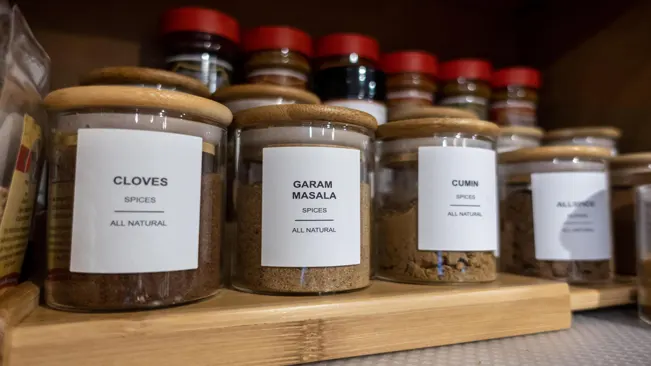
Cool and Dark Location
- Storing spices in a cool, dark place is vital because light and heat are the main culprits in degrading the quality of spices. Direct sunlight can break down the complex compounds in spices, leading to faded color and diminished flavor.
- The ideal location is often a pantry or a cupboard, particularly one that’s away from appliances that generate heat like stoves or ovens.
- It’s also wise to avoid placing spices near windows or under direct kitchen lights. Instead, choose a spot that remains consistently dark and cool.
Airtight Containers
- Oxygen exposure accelerates the oxidation process in spices, which can lead to a stale taste and loss of aroma. Airtight containers significantly slow down this process.
- Glass jars with tight-fitting lids are a popular choice because they are non-porous and don’t absorb smells. They also allow you to see the spice, making it easier to keep track of your inventory.
- Metal tins are another excellent option. They block light effectively and are also airtight if they close securely.
- It’s important to ensure the container is completely dry before adding spices, as any residual moisture can cause spoilage.
Avoiding Moisture
- Moisture can be detrimental to spices, leading to mold growth and clumping. Spices should always be stored in a dry place.
- Make sure that spices are completely dry before you store them. Any contact with water or steam during storage can ruin them.
- Using a dry spoon or measuring tool when handling spices is crucial. It prevents the introduction of moisture from wet utensils into the spice container.
Room Temperature Storage
- Spices should ideally be stored at a consistent room temperature, avoiding areas with temperature fluctuations.
- Kitchens can have variable temperatures, especially near cooking equipment. Heat from these sources can cause spices to lose their flavor more quickly and can also lead to condensation inside containers, which is harmful.
- Refrigeration is generally not recommended for most dry spices. The cold environment can introduce moisture when the spice is brought back to room temperature, potentially leading to mold.
Organizing Your Spice Rack
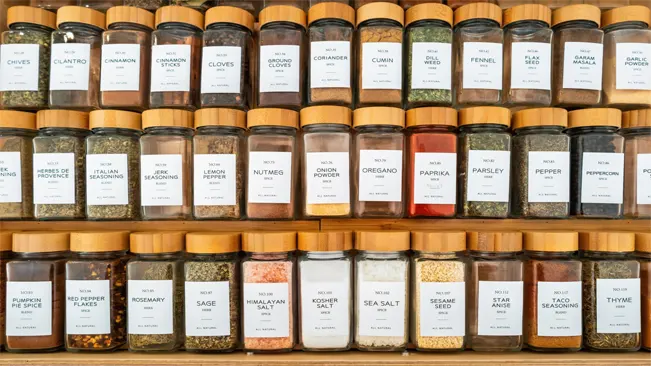
Labeling
- Freshness Tracking: By dating your spices, you can keep track of their age. Remember, spices don’t spoil like food but they do lose potency over time. The date helps you determine if a spice might be past its prime.
- Easy Identification: Clear labels prevent confusion, especially with spices that look similar. This saves time while cooking and ensures you’re using the right ingredient.
- Inventory Management: When you know what you have and how old it is, it’s easier to keep your spice inventory up-to-date, avoiding overbuying or running out of essential spices.
Rotation
- Maximizing Freshness: By using older spices first, you ensure that you’re always using the most potent and fresh spices in your cooking.
- Reducing Waste: This method prevents spices from sitting unused for too long and eventually losing their flavor.
- Systematic Usage: It keeps your spice rack orderly and functional, as you’re not just reaching for the same front-row spices every time.
Accessibility
- Frequently Used Spices: Place the spices you use most at the front or at an easily reachable height. This saves time and effort during cooking and reduces the exposure of other spices to air as you search for what you need.
- Special Occasion Spices: Spices used less frequently can be stored further back. Although they’re used less, remember to check their freshness periodically.
- Grouping by Cuisine or Flavor Profile: Some cooks find it helpful to group spices by the type of cuisine (e.g., Italian herbs together) or by flavor profile (e.g., all hot spices together). This can speed up the cooking process, especially when you’re following specific regional recipes.
Additional Tips
- Use Transparent Containers: Being able to see the spice without opening the container is not just convenient; it also prevents exposure to air.
- Consistency in Container Size and Shape: Uniform containers can make your spice rack look neat and can also maximize space efficiency.
- Digital Tools: For the tech-savvy, consider using a kitchen inventory app where you can keep track of your spices digitally.
Understanding Shelf Life
The shelf life of spices varies significantly based on their form (whole vs. ground) and type. It’s crucial to understand these differences to ensure your spices contribute the desired flavor and aroma to your dishes.
Whole Spices

- Whole spices, like cinnamon sticks, cloves, and peppercorns, last longer because they have less surface area exposed to the elements. Their essential oils, which contribute to their flavor and aroma, are better preserved in their whole form. Generally, whole spices can retain their potency for up to 4 years. However, this can be longer if they are stored optimally in a cool, dark place in airtight containers.
Ground Spices
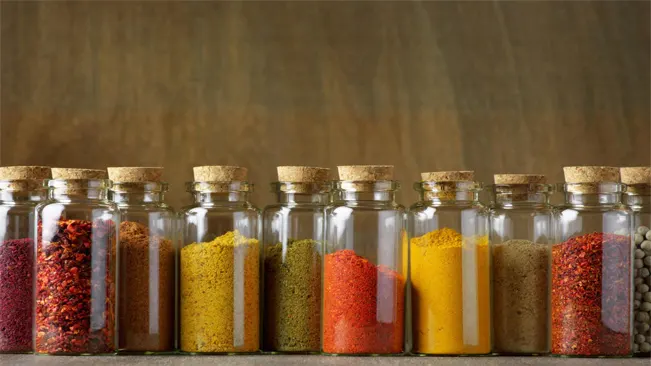
- Once spices are ground, they start losing their flavor and aroma more quickly due to increased exposure to air, light, and heat. Ground spices like turmeric, cumin, and paprika typically have a shelf life of 2-3 years. To maximize their shelf life, store them in airtight containers away from light and heat sources.
Dried Leafy Herbs
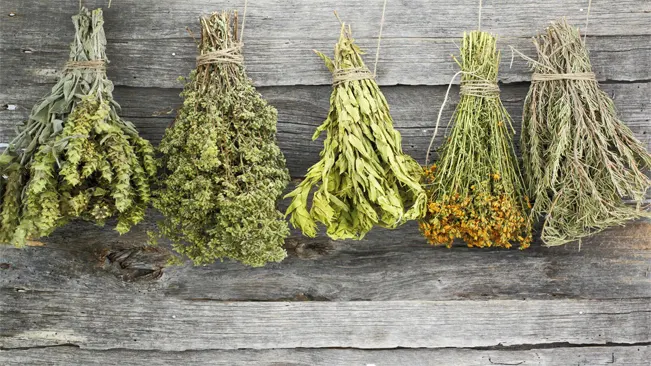
- Dried herbs like oregano, basil, and thyme have a shorter shelf life because their delicate oils evaporate faster. They usually retain their quality for 1-3 years. It’s essential to store them in airtight containers and check them periodically for any signs of loss in flavor or aroma.
Factors Affecting Shelf Life
- The environment plays a significant role in the shelf life of spices. Exposure to heat, light, and moisture can drastically reduce their lifespan. Humidity can cause clumping and mold growth, especially in ground spices.
Checking for Freshness
- To test if a spice is still potent, rub a small amount between your fingers and smell it. If the aroma is weak or stale, the spice may have lost its flavor. You can also look for color fading as an indication of reduced quality.
Buying in Appropriate Quantities
- Consider purchasing spices in quantities you can use within their optimal freshness period. This approach is more efficient than buying in bulk and risking the spices losing their potency over time.
Special Considerations
Special Storage Requirements for Vanilla and Saffron
Vanilla

- Type of Vanilla: Vanilla comes in several forms – beans, extract, and powder. Each has different storage needs.
- Vanilla Beans: Store them in an airtight container at room temperature, away from light and heat. They should be kept in their original packaging or wrapped in wax or parchment paper and then placed in the container.
- Vanilla Extract: Keep it in its original dark glass bottle, tightly sealed, and stored in a cool, dark place like a pantry. It’s generally stable and has a long shelf life due to its alcohol content.
- Vanilla Powder: Store in an airtight container in a cool, dry place. Ensure it’s away from moisture to prevent clumping.
Saffron
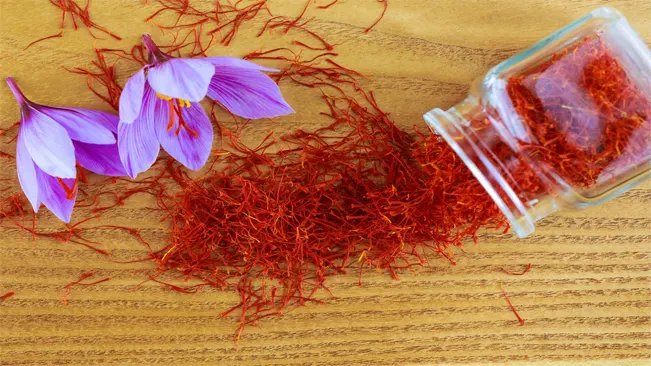
- Light and Air Sensitive: Saffron is highly sensitive to light and air. Store it in a dark, airtight container to protect it from light and air exposure.
- Cool Environment: Like most spices, saffron should be stored in a cool place. A cupboard or a spice drawer away from heat is ideal.
- Avoid Humidity: Ensure the storage area is dry, as humidity can degrade saffron’s quality and lead to mold.
Benefits of Buying Spices in Small Quantities
- Peak Flavor Usage: Spices lose their potency over time. Purchasing in small amounts means you are more likely to use them while they are still at their peak of flavor.
- Reduced Waste: Buying only what you need can reduce waste, both in terms of unused spices and packaging.
- Fresher Spices: Frequent purchasing ensures that you are getting fresher spices, as they haven’t been sitting on your shelf for an extended period.
- Variety Without Bulk: It allows you to have a variety of spices without the need to store large quantities, which is particularly beneficial in smaller kitchens.
- Seasonal Cooking: Buying in small quantities is ideal for seasonal recipes or experimenting with new flavors without committing to a large amount.
Conclusion
Properly preserving and storing spices is crucial for any kitchen. By following these simple yet effective strategies, you can ensure your spices retain their potency and flavor, elevating your culinary creations to new heights.
FAQs (Frequently Asked Questions)
- What is the best way to store spices to keep them fresh?
- Store spices in a cool, dark place in airtight containers. This helps protect them from light, air, and moisture, which can reduce their potency.
- Store spices in a cool, dark place in airtight containers. This helps protect them from light, air, and moisture, which can reduce their potency.
- Can spices be stored in the refrigerator or freezer for longer shelf life?
- Generally, it’s not recommended to store spices in the refrigerator or freezer as the humidity and temperature changes can cause condensation and affect their quality. However, some exceptions like fresh chili paste or pure vanilla extract can be refrigerated.
- Generally, it’s not recommended to store spices in the refrigerator or freezer as the humidity and temperature changes can cause condensation and affect their quality. However, some exceptions like fresh chili paste or pure vanilla extract can be refrigerated.
- How long can spices be stored before they lose their flavor?
- Whole spices can last about 3-4 years, ground spices 2-3 years, and dried leafy herbs 1-3 years. However, this can vary depending on the spice and storage conditions.
- Whole spices can last about 3-4 years, ground spices 2-3 years, and dried leafy herbs 1-3 years. However, this can vary depending on the spice and storage conditions.
- Can I store all my spices in a rack above the stove?
- It’s better to avoid storing spices above the stove or near any heat source, as heat can cause spices to lose their flavor more quickly.
- It’s better to avoid storing spices above the stove or near any heat source, as heat can cause spices to lose their flavor more quickly.
- Is it necessary to store spices in glass jars?
- Glass jars are preferred because they are airtight and don’t transfer odors. However, any airtight container, including metal tins or plastic containers, can be suitable as long as they are kept away from light.
- Glass jars are preferred because they are airtight and don’t transfer odors. However, any airtight container, including metal tins or plastic containers, can be suitable as long as they are kept away from light.
- How can I tell if a spice is no longer good to use?
- Check for changes in color, aroma, and taste. If the spice looks faded, smells weak, or has lost its flavor, it’s time to replace it.
- Check for changes in color, aroma, and taste. If the spice looks faded, smells weak, or has lost its flavor, it’s time to replace it.
- Should I freeze whole spices to keep them fresh?
- Freezing is not typically recommended for spices as the condensation from freezing and thawing can affect their quality. Keeping them in a cool, dry place is usually sufficient.
- Freezing is not typically recommended for spices as the condensation from freezing and thawing can affect their quality. Keeping them in a cool, dry place is usually sufficient.
- How important is it to label spices with the date of purchase?
- Labeling spices with the date of purchase can help you track their freshness and ensure you use older spices first.
- Labeling spices with the date of purchase can help you track their freshness and ensure you use older spices first.
- Can I use plastic bags to store spices?
- While plastic bags are not the ideal storage solution due to their permeability to air and odors, they can be used temporarily if sealed well and kept in a dark, cool place.
- While plastic bags are not the ideal storage solution due to their permeability to air and odors, they can be used temporarily if sealed well and kept in a dark, cool place.
- Is it okay to store spices near a window?
- Storing spices near a window is not advisable as the sunlight can degrade their quality over time. It’s best to store them in a dark cabinet or pantry.

Kristine Moore
Forestry AuthorI'm Kristine Moore, a seasoned garden landscaping professional with over 30 years of experience. My extensive career has been dedicated to transforming outdoor spaces into stunning, sustainable landscapes. With a deep understanding of horticulture, design principles, and environmental stewardship, I have become a respected figure in the field, known for creating harmonious, visually appealing, and eco-friendly gardens. My commitment to excellence and continuous learning in landscaping trends and techniques has solidified my reputation as an expert in garden design and implementation.


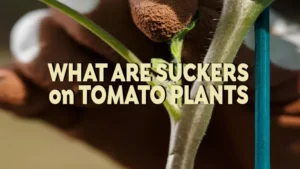
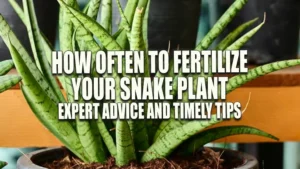


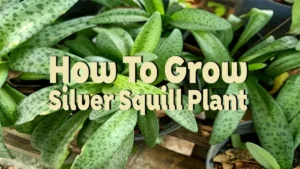



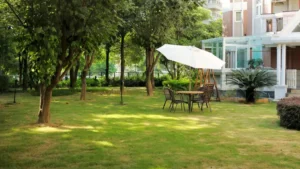


Leave your comment